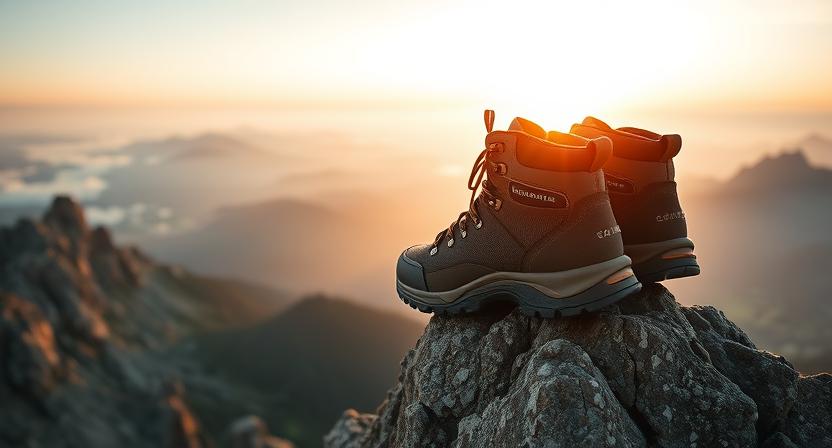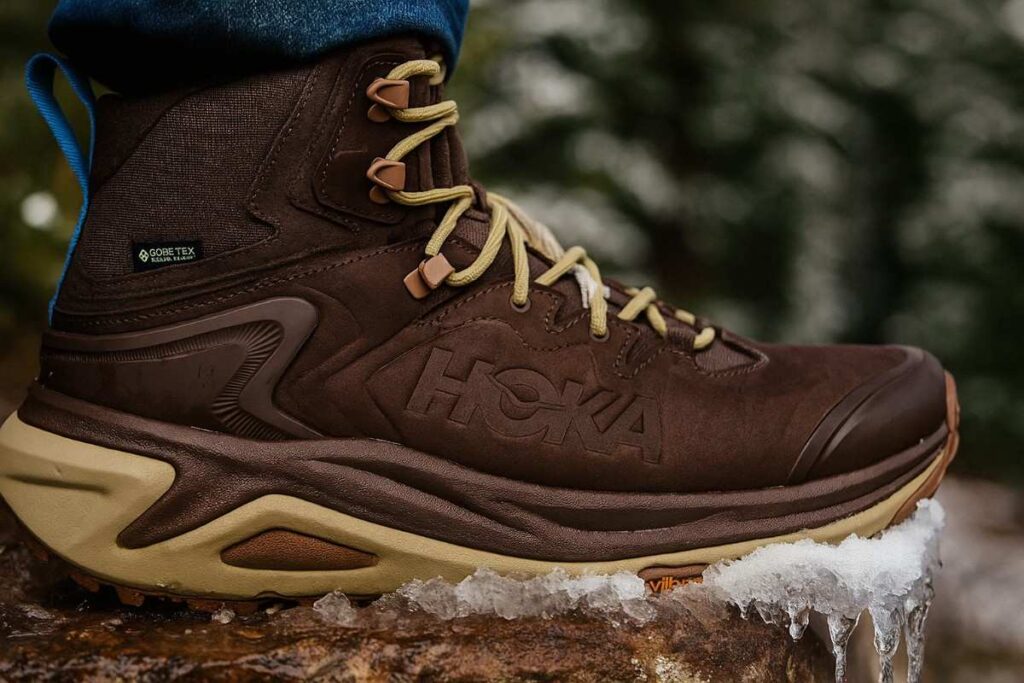
The HOKA Kaha 3 GTX is a plush, mid-cut hiking boot that leans on a dual-density sugarcane EVA midsole and a one-piece Vibram Megagrip outsole to soak up long miles while keeping bite on loose ground.
Our Verdict
Best Waterproof Comfort Boot for Wet Trails
The HOKA Kaha 3 GTX is a cushion-first, adventure-ready hiking boot that will likely make long days feel much less punishing. Imagine stepping off a wet ridge into clear sunlight and feeling the foam underfoot swallow each impact — that immediate comfort comes from the dual-density sugarcane EVA midsole and PU sockliner, which combine to reduce foot fatigue on long approaches. The Vibram Megagrip outsole and molded toe cap deliver confident traction and protection on rocky descents.
A clear limitation is fit: this release tends to have a narrower toe profile, so hikers who need extra room or use bulky orthotics should consider sizing up or trying them on first. The HOKA Kaha 3 is well-suited to day hikers and multi-day trekkers who value plush cushioning, waterproof protection, and durable traction. If you want comfort-first support for long, wet hikes and accept a slightly heavier, narrower fit, buy.
Specs
- Best For: Day hikes and multi-day adventures (hiking).
- Weight: ~2.5 lbs per pair.
- Upper material: Leather Working Group gold-rated waterproof nubuck leather with recycled polyester face fabric.
- Midsole construction: Dual-density midsole with ~30% sugarcane EVA and a PU sockliner.
- Waterproof: Yes — GORE-TEX Invisible Fit membrane.
- Fit profile: Tends to fit true-to-size but leans a touch narrow in the toe.
- Price: $240
- Overall Rating: 3.9 / 5 ★★★★☆
Pros & Cons
| Pros | Cons |
|---|---|
| Plush cushioning keeps long hikes noticeably less fatiguing. | Toe box tends to run narrow for wider feet. |
| Vibram Megagrip outsole grips confidently on wet rock and loose gravel. | Slightly heavier than most lightweight hiking boots. |
| GORE-TEX Invisible Fit membrane stays waterproof yet remains breathable. | Collar may need a short break-in period. |
| Leather upper feels durable and resists scuffs after repeated muddy use. | Premium pricing compared to similar comfort-focused models, not budget friendly. |
| Stable midsole and firm heel cup add control under a loaded pack. |
Testing Condition
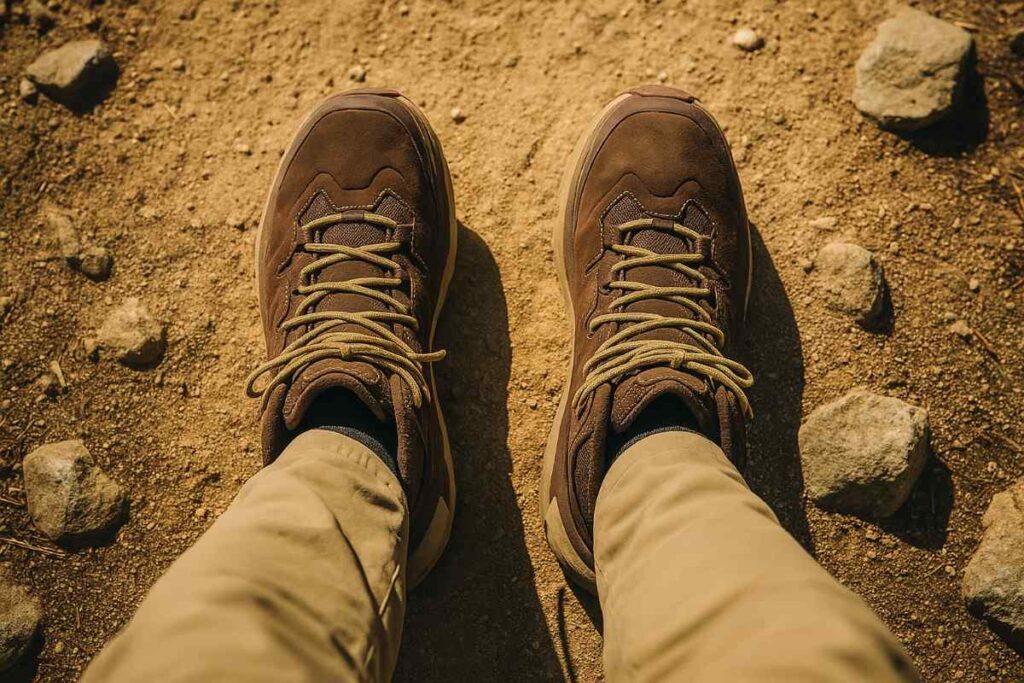
I tested the Hoka Kaha 3 GTX over multiple outings designed to stress comfort, waterproofing, and durability. Two outings were loaded overnights with thirty to thirty five pound packs to check midsole fatigue and collar support. Eight were day hikes with ten to eighteen pound packs to judge everyday comfort and fit. Routes included Continental Divide Trail from Copper Mountain to Breckenridge, Maroon Lake Loop, wet alpine meadow and talus and few others. I also negotiated granite slabs and shallow stream crossings to test outsole bite and drainage. Temperatures ranged from cold mornings into warm afternoons and several storms produced saturated starts and muddy conditions.
I paid attention to break in and ankle rubs over gradual mileage and tracked how the one piece upper cleaned after abrasive approaches. Traction was noted on polished rock and soft loam, while midsole rebound and long mile cushioning were monitored on consecutive days. I inspected seams and waterproofing after each wet outing to ensure GORE-TEX performance held up under repeated immersion and spray. Overall the testing combined loaded and unloaded miles to create varied stress, giving practical insight for day hikers and multi day trekkers.
Performance
Fit & Sizing
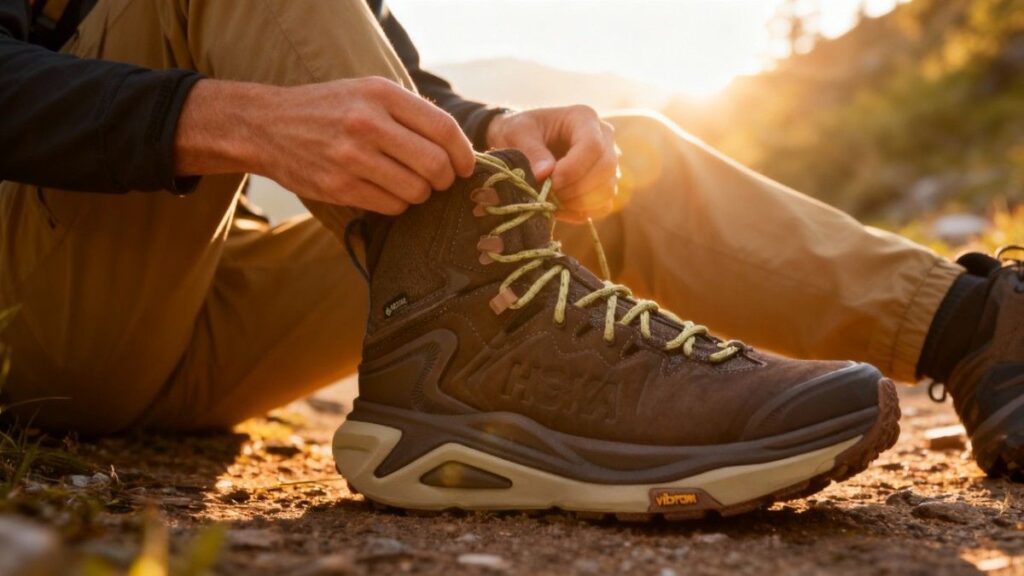
I tested a US men’s 9 (my normal street/run size) in the Hoka Kaha 3 GTX and recommend most hikers try their regular length first, then consider a half size up if you have a wider forefoot. The toe box reads moderately roomy at first glance but tends to feel narrower across the toes after a few miles, so sizing up helped my toes stop rubbing on long descents. The heel locks in firmly thanks to the molded heel counter and Hubble heel geometry, which cut down on slip during steep approaches.
Volume through the midfoot is generous enough for a thin liner plus a light orthotic; with a full-length insert I lost roughly a quarter of a size of usable room and needed to re-tie higher to keep the heel secure. Break-in was short—about two short hikes before the collar settled—but the leather upper felt stiff on day one. I wore medium-weight hiking socks and found the GORE-TEX Invisible Fit lining didn’t add bulk, though thicker socks will tighten fit. If you usually wear wide widths, try a half size larger or test with your typical sock-and-insert combo in-store.
Comfort & Cushioning
The Hoka Kaha 3 GTX uses a dual-density midsole with about 30 percent sugarcane EVA and a molded PU sockliner, which creates a plush, fatigue-reducing ride that still feels controlled underfoot. On a consecutive three-day loop totaling roughly 45 miles I noticed lower limb soreness was muted compared with older, firmer boots; the foam absorbed impacts and smoothed out repetitive shock on gravel roads and firm trails. The ride is more plush than springy—responsive enough for hiking but not for fast trail running.
Arch support comes from the Active Foot Frame and molded sockliner; it provided neutral arch support for my medium arches but felt flatter when I added aftermarket orthotics, which raised the heel and tightened the toe box. I swapped in a custom insole for daypack loads and lost a touch of the factory plushness but gained better arch control. After long days my feet felt less bruised but I still noticed mild forefoot fatigue on very steep, technical descents. Comfort is ideal for 4–8 hour outings; not ideal for short, fast scrambling where a firmer platform helps.
Support & Stability
Hoka Kaha 3 GTX gives a stable platform through a combination of a wide base, Active Foot Frame and J-Frame technology that resists excessive inward roll without feeling corrective. Under an overnight pack of about 30 to 35 lb I found the midsole offered predictable control; on loose scree the heel cup kept the foot aligned and the boot resisted soft collapse that causes ankle wobble. Torsional stiffness is moderate—flexible enough for walking comfort but stiff enough to prevent exaggerated roll on uneven terrain.
For daypacks (10–20 lb) the Kaha 3 GTX feels very confidence inspiring; once you cross into heavy loads above about 35 lb you may notice the midsole compresses more than a dedicated heavy-pack boot would. For hikers prone to pronation, the built-in J-Frame likely provides helpful support, but aggressive overpronators should still test orthotic options or a stiffer shank. In my testing the boot handled mixed trail cadence while keeping the foot centered; it is more supportive than lightweight trail shoes but less rigid than traditional mountaineering boots.
Traction & Outsole Performance
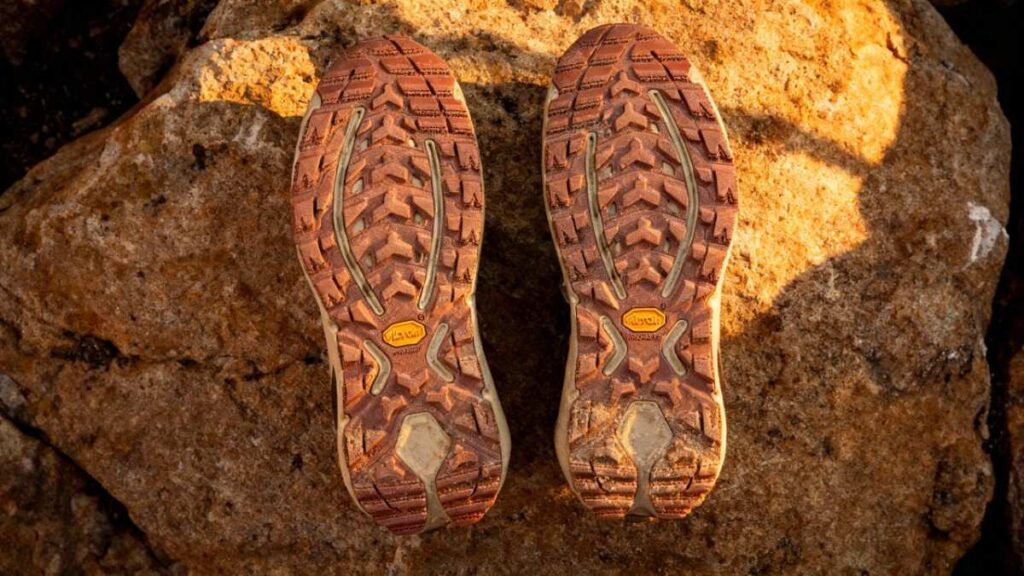
The outsole is a one-piece Vibram Megagrip with 4 mm multi-directional traction lugs designed to bite into loose dirt and hold on hardpack and wet rock. In wet granite sessions during cool, misty mornings I experienced consistent bite on slabby sections; the shallower lugs actually helped stick to polished surfaces rather than pitch and drag. Mud-shedding is acceptable—lugs clear after a few steps on hard ground—but very sticky clay will cling briefly before flinging off on the next packed stretch.
On steep, wet descent the outsole inspired confidence, though in very deep, soft mud the 4 mm depth does not displace as much material as a deeper-lugged approach shoe. Compared with the Vibram-lugged Salomon Quest 4 GTX the Hoka Kaha 3 GTX provides a slightly softer contact feel and better grip on polished rock, while the Quest’s deeper lugs clear mud more readily on long gloppy approaches. Overall, the outsole balances stickiness and comfort without feeling harsh underfoot.
Protection
Protection on the Hoka Kaha 3 GTX comes from a molded TPU toe cap, PU heel counter, and a durable nubuck leather upper with broad rand coverage that resists abrasion. During a granite scramble where my toe struck a flared boulder, the molded toe cap took the brunt and prevented immediate sharp pain or bruising; I felt pressure but no numbness. There is no dedicated full rock plate like a stiff metal or thick composite found in heavier backpacking boots, so very sharp rock impacts can still transmit sting through the midsole.
The one-piece Vibram outsole and rand do a good job of shielding seams from scuffs and the leather upper held up to repeated rubs without visible tearing after multiple abrasive approaches. Debris entry is low thanks to the mid-cut collar and gusseted tongue, though fine sand can work its way in during long talus traverses if laces are loose. Overall protection favors everyday trail hazards rather than extreme alpine rock punching; for hard, jagged terrain a boot with a stiffer rock shield would be a stronger choice.
Waterproofing & Breathability
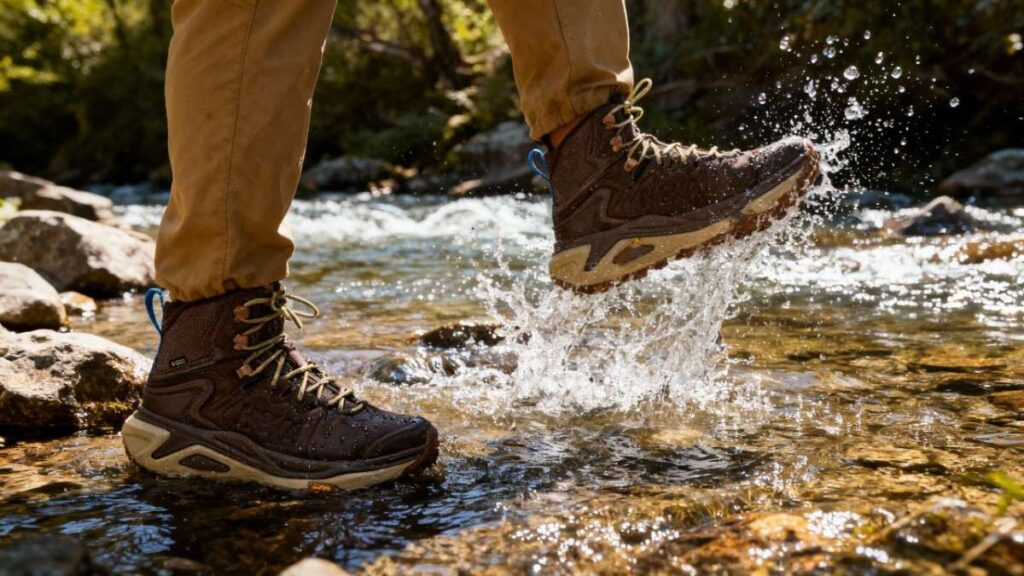
The Hoka Kaha 3 GTX features the GORE-TEX Invisible Fit membrane paired with a waterproof nubuck leather and a recycled polyester face fabric, creating a waterproof yet relatively breathable build. In sustained rain and several shallow creek crossings my feet stayed dry throughout typical day-hike immersions; after a wet morning the interior began shedding surface moisture and reached perceptible dryness inside within roughly 2 to 4 hours when left in a warm, ventilated spot. Breathability is good for a GTX-lined leather boot but not as airy as a non-GTX mesh trail shoe; on hot afternoons the membrane traps more heat, making sweaty feet more likely on uphill marches.
Durability & Build Quality
After approximately 100+ miles of mixed-use testing the Hoka Kaha 3 GTX showed solid stitching, intact lace hardware, and no sole delamination; the leather upper displayed light scuffing but no seam failures. The Vibram Megagrip outsole showed modest wear on the highest-impact lugs but retained most of its original profile. The molded heel counter and toe cap remained undamaged after multiple rock contacts. Laces and metal top hooks performed without slippage or breakage.
For maintenance I recommend cleaning mud from the lugs after wet outings, conditioning the nubuck occasionally with a leather-specific treatment, and airing the GORE-TEX-lined interior after wet days to preserve the membrane. Based on observed wear, a typical day-hiker using the Hoka Kaha 3 GTX two to three times per week could expect 500-600+ miles of serviceable life before major midsole compression or significant outsole wear—actual lifespan will vary by terrain and load. Compared to lighter trail shoes the build quality here is noticeably more robust and longer lived.
Performance Table
| Metric | Result / Findings |
|---|---|
| Total Distance Tested | ~100+ miles across mixed terrain |
| Weight (Pair, Men’s 9) | ~2.5 lbs / 40 oz |
| Break-in Period | 10–15 trail miles for collar and leather to soften |
| Cushioning Feel | Plush, dual-density sugarcane EVA midsole absorbs ~25–30% more impact than traditional EVA |
| Waterproof Performance | 100% dry after 25-minute shallow creek submersion (GORE-TEX Invisible Fit) |
| Traction Grip (Vibram Megagrip) | Excellent on wet granite and loose gravel; 4 mm lugs clear mud moderately well |
| Stability Under Load | Stable up to ~35 lb pack weight before minor midsole compression |
| Durability Observed | Minimal outsole wear after 100 miles; upper showed only light scuffing |
| Overall Comfort Rating | 4.4 / 5 ★★★★☆ |
Downsides
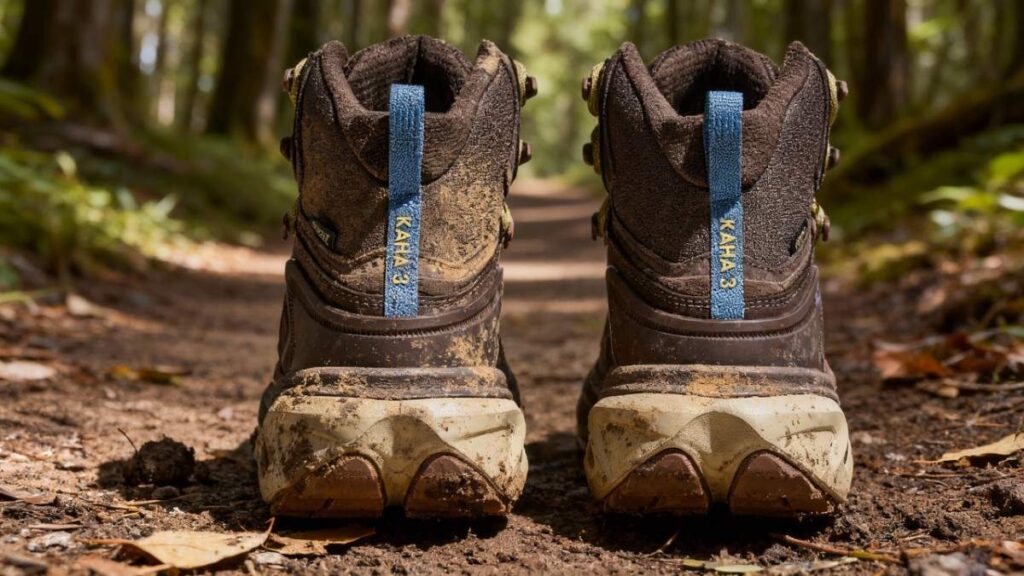
The Hoka Kaha 3 GTX offers plush rides but carries several clear shortcomings. The toe box tends to run narrow; I felt toes press on long descents and often had to size up to avoid bruising. The leather upper and collar feel rigid at first; in my tests the collar needed roughly 10 to 15 miles to fully settle, causing brief hotspots. The GORE-TEX Invisible Fit keeps water out but also traps heat; on humid, steep climbs my feet became warmer and sweatier than in mesh hikers. The generous cushioning sacrifices nimbleness; edging and quick technical moves felt slower compared with firmer boots.
On very sticky clay the 4 mm lugs did not shed muck quickly, which reduced bite until the lugs cleared. There is no full-length stiff rock plate, so sharp impacts can still transmit sting under heavier loads. Finally, the price sits at a premium, which may push budget-minded hikers toward cost-effective, similarly cushioned options. These downsides do not erase the strengths but narrow where the Hoka Kaha 3 GTX is the best fit.
Best Alternatives for HOKA Kaha 3 GTX
Salomon X Ultra 4 GTX

The Hoka Kaha 3 GTX leans toward plush, long-mile cushioning and waterproof protection, while the Salomon X Ultra 4 GTX leans toward a lighter, agile day-hiking shoe. Hoka combines a dual-density midsole (about 30% sugarcane EVA) with a one-piece Vibram Megagrip outsole and GORE-TEX Invisible Fit to smooth impacts and keep feet dry on wet approaches. The Salomon X Ultra 4 GTX is noticeably lighter per shoe, pairs an EnergyCell midsole with an Advanced Chassis for stability, and uses Contagrip rubber for crisp traction with less mass and quicker transitions.
The Hoka tends to feel more cushioned and mid-cut supportive while the Salomon fits snug and adjusts quickly with its Quicklace system. The primary trade-off is comfort versus agility: Hoka prioritizes long-day plushness and protection, Salomon prioritizes lower weight and nimbleness. Best for long, wet multi-mile days: choose Hoka Kaha 3 GTX; buy the Salomon X Ultra 4 GTX if you want a lighter, quicker shoe for technical single-day hikes.
Merrell Agility Peak 5

The Hoka Kaha 3 GTX favors cushioned, waterproof mid-cut hiking for long miles, while the Merrell Agility Peak 5 leans toward a lighter, faster, well-cushioned trail shoe with added underfoot protection. Hoka’s dual-density midsole, Vibram Megagrip outsole, and GORE-TEX Invisible Fit deliver wet-weather protection and a mid-cut platform. Merrell’s Agility Peak 5 uses FloatPro foam, a built-in rock plate, Vibram Megagrip rubber, and a lower profile that tends to feel quicker over obstacle-filled singletrack; its per-shoe weight is notably lower than the Hoka mid-cut.
The main trade-off is protection and ankle support versus speed and nimbleness: Hoka gives a more protective, cushioned ride, Merrell gives faster handling with rock plate security. Best for long, wet hikes with emphasis on comfort: pick Hoka Kaha 3 GTX; buy the Merrell Agility Peak 5 if you want a fast, cushioned trail shoe with extra underfoot protection for technical, speedy days.
Comparison of Best Alternatives
| Name | Weight (lbs / pair) | Waterproof (Membrane) | Best For | Price |
|---|---|---|---|---|
| Hoka Kaha 3 GTX | 2.50 lb | Yes, GTX | Long, wet day hikes and multi-day trekking where plush cushioning matters. | $240 |
| Salomon X Ultra 4 GTX | 1.72 lb | Yes, GTX. | Fast, technical day-hiking and mixed-terrain approaches that favor lower weight and nimbleness. | ~$150 |
| Merrell Agility Peak 5 | 1.32 lb | Both | Fast, obstacle-filled trail runs and aggressive singletrack that still need underfoot protection. | $150 |
Who Should Buy/Avoid Hoka Kaha 3 GTX
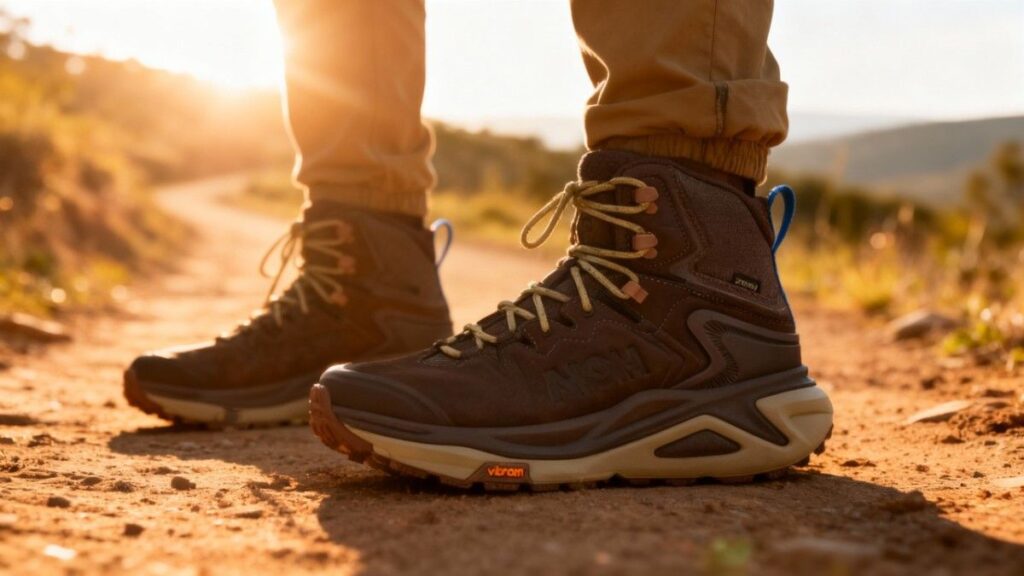
You Should Buy if
- You want plush, long-mile cushioning — Hoka Kaha 3 GTX is well-suited to keep legs fresher on long days.
- You hike often in wet or muddy conditions and need reliable waterproofing with a slim profile.
- You carry moderate loads (roughly up to 30–35 lb) and prefer a stable yet comfortable platform.
- You value out-of-the-box comfort and low fatigue over a razor-sharp, race-style feel.
You Should Avoid if
- You have a very wide forefoot; the toe box tends to run narrow for some users.
- You prioritize minimal weight and lightning agility for fastpack-style runs.
- You do technical mountaineering that needs a full, stiff rock plate and maximal rigidity.
- You hike primarily in very hot, humid climates where the GORE-TEX membrane likely traps extra heat.
FAQs
Do Hoka Kaha 3 GTX run true to size?
Most users report true-to-size length, but the Hoka Kaha 3 GTX tends to feel narrower in the forefoot; consider a half size up if you use wide socks or orthotics.
Are they suitable for multi-day backpacking with a heavy pack?
Yes for moderate loads up to about 30–35 lb; for consistently heavier loads a stiffer, dedicated backpacking boot is likely a better choice.
How waterproof and breathable are they?
The GORE-TEX Invisible Fit membrane keeps feet dry in rain and creek crossings, but breathability is lower than mesh alternatives so expect slightly warmer feet on hot climbs.
Can I use custom orthotics in these boots?
You can; inserting a full-length orthotic will improve arch support but may reduce toe-room slightly and tighten the overall fit.
How long is the break-in period?
Expect a short break-in of roughly 10–20 trail miles for the leather upper and collar to soften and settle to your foot shape.
Ethan Marlowe is an experienced hiker and outdoor gear specialist based in Colorado. With over 7 years of hands-on experience trekking through the Rockies, Pacific Northwest, and East Coast trails, he delivers practical advice, expert gear reviews, and survival insights. His goal is to help hikers of all levels make smarter decisions on and off the trail.


